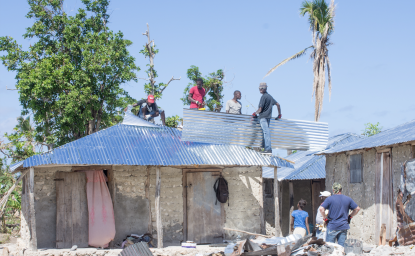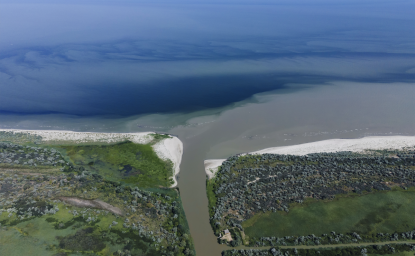Click here to download ECSP Report 10.
Solving population, environment, and health problems is a cheap way to prevent conflict, according to Pulitzer Prize-winning author Jared Diamond, in the latest issue of the groundbreaking Environmental Change & Security Project Report. "People in countries with severe population, environment, and health problems get desperate. If they have no hope, they turn to drastic things like civil war and terrorism." Diamond advocates a less expensive solution: "It would be relatively cheap to solve the world's public health problems, which if left untreated, may ultimately lead to the explosions that cause us to send in our troops. The Band-Aids cost much more than the antibiotic." Klaus Toepfer, the executive director of the United Nations Environment Programme, agrees: "Environmental security is the disarmament policy of the future."
But what is the future of environmental security, according to the experts? 2004 brought mixed results: ten years after environmental security exploded on the political scene in the aftermath of state failures in Somalia, Rwanda, and Liberia, Wangari Maathai won the Nobel Peace Prize for her work linking sustainable development and human rights. But the Pentagon is considering removing a directive to display environmental security leadership. The Woodrow Wilson Center's Environmental Change & Security Project (ECSP), the leading institute for environmental security in the United States, asked top thinkers to identify key themes for the next ten years: What are the next steps for environment, population, and security?
Eminent scientist Jared Diamond sees hope in individual action: "Every one of our problems—deforestation, overfishing, water scarcity, and toxic waste—is of our own making. Therefore, we can choose to stop causing them." He offers inexpensive steps that individuals can take to address these problems: vote, speak out on public policy, exercise consumer choice, and support collaborations between big businesses and environmental organizations.
Former European Commission environment official Margaret Brusasco-Mackenzie urges us to regain lost momentum: "Clearly, the new model of development—one that could ensure environmental security—has been put on the back burner by the hostilities in Iraq and the war on terrorism," she says, highlighting some of the European Union's recent efforts to reinvigorate environmental security in a world dominated by "hard" security headlines.
Richard Cincotta of Population Action International connects demographics to security risks: "Early-phase states—including Iraq, Pakistan, and Nigeria—might lower their risk of civil conflict during their transitions to democracy and free markets if they advanced through the demographic transition" and reduced their birth rates, according to Cincotta, who outlines concrete steps for untangling these correlations. "U.S. foreign policy should improve girls' access to schooling and women's access to family planning, maternal health care, and income-generating opportunities."
Erika Weinthal of Tel Aviv University finds environmental paths to making peace—and keeping it—in Central Asia and the Middle East. "Israeli and Palestinian water managers continued to cooperate—even as other forms of economic and security cooperation collapsed—after the second intifada began in 2000," she points out. "The Middle East could be a striking example of moving from environmental peacemaking to environmental peacekeeping."
Roger-Mark De Souza of the Population Reference Bureau encourages integrating population, health, and environment programs: "Short-term solutions for a single sector are unlikely to be effective over the long term," he says. Without systematically documenting and advertising the benefits of integration, population-health-environment programs may not be supported by policymakers and donors.
Richard Matthew and Bryan McDonald of the Center for Unconventional Security identify a new 21st century security agenda: "National and international security agendas are focusing as much attention on ‘network-based threats'—terrorism, computer viruses, and epidemic diseases, for example—as on the perennial problem of war," according to the coauthors, who use lessons from environmental security research to develop this concept.
ECSP Director Geoffrey Dabelko advises researchers and policymakers to act fast to avoid missing opportunities to build peace. "Instead of merely reacting to the symptoms of environment-conflict linkages, policymakers should proactively extinguish hotspots by bolstering confidence and building cooperation," he asserts. "And the academic world should stop arguing over two sides of the same coin, and instead explore how livelihood security could encourage cooperation and prevent conflict."
The redesigned 10th anniversary issue of the ECSP Report, the only forum dedicated to showcasing environmental security, also features these sections:
Can the United Nations preserve peace by protecting the Earth? Three papers commissioned by the United Nations Foundation for the Secretary-General's High-Level Panel on Threats, Challenges, and Change, argue that problems like food insecurity, water pollution, and climate change could reduce human security and potentially destabilize nations, if the United Nations does not fundamentally change the way it confronts and prevents environmental threats to security.
Decades of population growth in Ethiopia have contributed to overfarming and deforestation, which have degraded the environment and undermined development. Sahlu Haile of the Packard Foundation decries the half-hearted attempts to control Ethiopia's population growth—and the de facto demolition of his country's natural resources.
Book reviews cover a broad spectrum of new publications that address the connections among population, health, environment, and security.
A new column—"dotPop"—illustrates the wealth of population data available online.
Click here to download ECSP Report 10.
Related Links




